Manuals for repair and maintenance of Japanese motorcycle Kawasaki Versys
See this section in russian language
This section contains detailed instructions for repairing and maintaining Japanese motorcycles «Kawasaki Versys KLE 650», which have been produced since 2007 to the present.
Description and history of Japanese motorcycles Kawasaki Versys
The Kawasaki Versys is a family of motorcycles of various types produced by Kawasaki since 2007.
| Content: | Versys-X 300 Versys-X 250 KLE 650 Versys KLE 1000 Versys |
Versys-X 300 (2017-present)
The Kawasaki Versys-X 300 is part of the Versys family and has been in production since 2017, undergoing annual updates. A 250 cc variant is also produced, available in select markets.
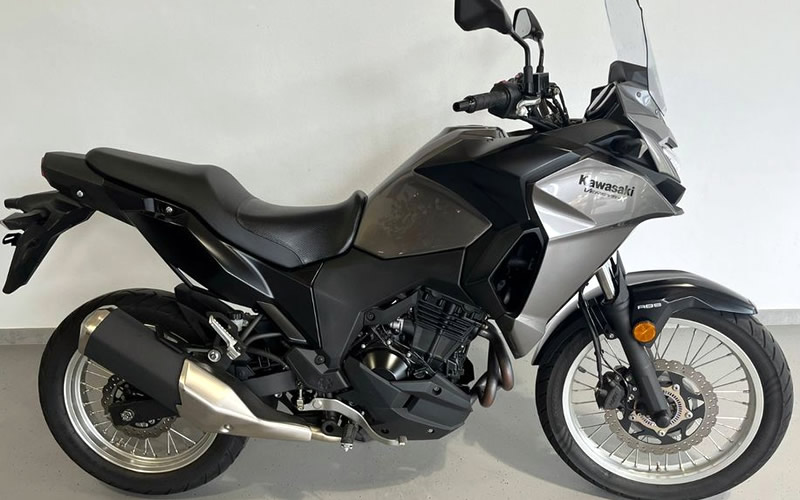
Versys-X 300, 2018 year, right view
Unveiled in late 2016, the Versys-X 300 is the smallest offering in Kawasaki's Versys lineup, with production commencing for the 2017 model year. This motorcycle was designed to meet the needs of riders seeking a lightweight and agile machine suitable for commuting, touring, and light off-road adventures, all while being more affordable than the larger 650 cc and 1000 cc models. With a seat height of 815 mm, it is particularly accommodating for shorter riders. An optional seat that raises the height by 25 mm is also available. The engine is a water-cooled parallel-twin derived from the Kawasaki Ninja 300, but it has been tuned to enhance torque delivery at lower RPMs, improving its off-road capabilities. In the U.S., the bike can be equipped with optional ABS, while all units sold in Japan, Australia, and Canada come standard with this feature. In Australia, it is eligible for the Learner Approved Motorcycle Scheme (LAMS), allowing novice riders to operate it.

Versys-X 300, 2019 year, left view
The transmission system includes an assist and slipper clutch, which eases the clutch lever pull and facilitates aggressive downshifting, along with a positive neutral finder for smoother gear transitions. The motorcycle is fitted with Trail Winners tyres from Inoue Rubber Co., which are well-suited for general road use and light off-roading. It features spoked wheels with aluminum rims.
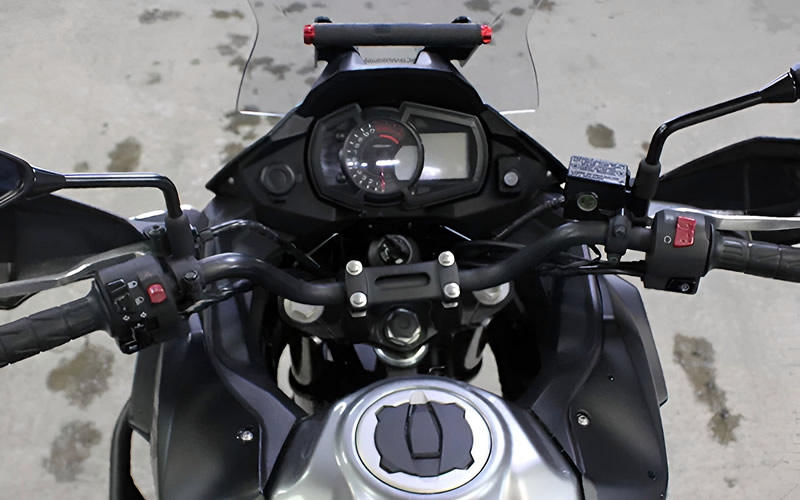
Versys-X 300, 2020 year, dashboard
Versys-X 250 (2017-present)
Since its introduction in 2017, the Versys-X 250 has been exclusively manufactured for the Japanese market. As of 2022, it is also available in Indonesia, Malaysia, and Thailand. Aside from its engine, which is sourced from the earlier Ninja 250, the Versys-X 250 shares nearly all features with the Versys-X 300. The smaller engine produces 24.0 kW of power and 21.0 Nm of torque.
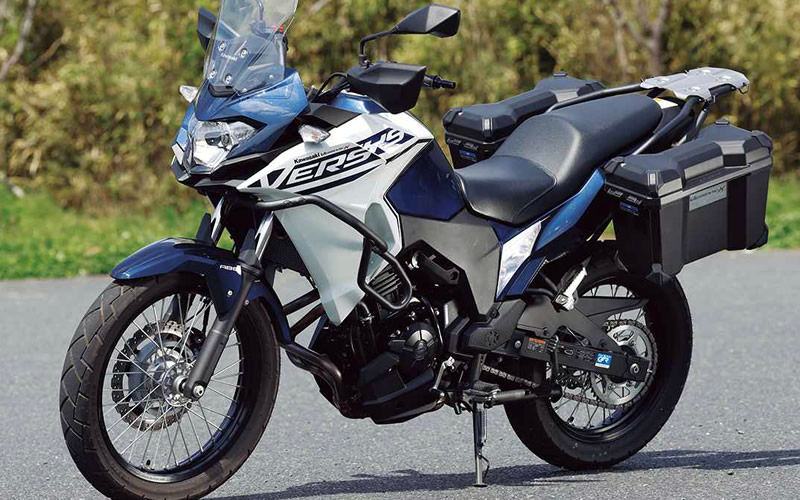
Versys-X 250, 2022 year, front view
The Versys-X 250 Tourer ABS, available since 2017 and the sole 250 cc model since 2020, comes equipped with features that are optional for the Versys-X 300. These include a set of 17-liter keyed-alike plastic panniers, a center stand, an engine guard bar, and a power socket.
KLE 650 Versys (2007-present)
The KLE 650 Versys is a motorcycle from the Japanese manufacturer Kawasaki, which has been available on the European market since late 2006. The name of this sport touring bike is derived from the English term "versatile system".
Direct competitors in the market include the Suzuki DL 650 V-Strom (from the beginning) and the Yamaha Tracer 700 (since around 2016), as well as the Honda Transalp until 2012 and the BMW F 650 GS and BMW F 700 GS until 2018.

KLE 650 Versys, 2008 year, left view
The design of the Versys was created by the designer of the Mazda MX-5, Shunji Tanaka. The technology is based on the Kawasaki ER-6 series but features longer suspension travel, an adjustable upside-down fork with a 41 mm diameter, and a half fairing. The engine has been optimized for better torque in the lower and mid RPM ranges.
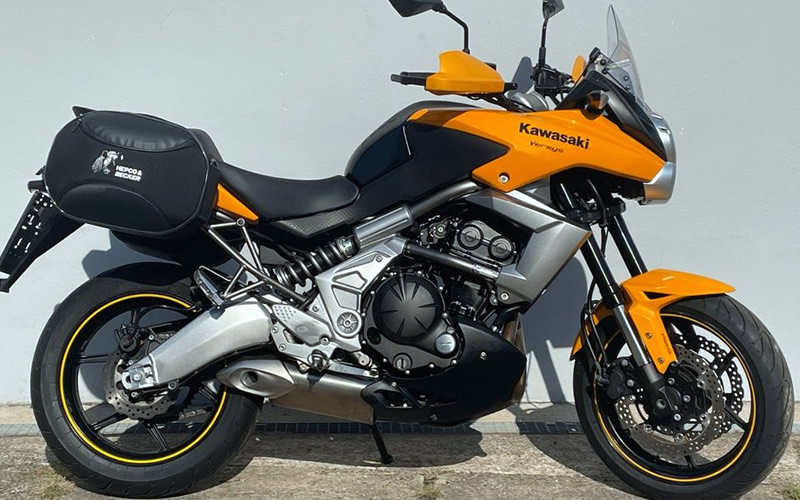
KLE 650 Versys, 2011 year, right view
The liquid-cooled twin-cylinder engine produces a rated output of 51 kW (69 hp) and a maximum torque of 64 Nm at an engine speed of 7000 rpm from a displacement of 649 cc. The two cylinders of the inline engine have a bore of ⌀83 mm, the pistons have a stroke of 60 mm, and the compression ratio is 10.8:1. Additionally, the engine features a balance shaft. In the cylinder head of the four-stroke engine, two overhead camshafts operate two intake and two exhaust valves via tappets. Since 2015, the exhaust system has been made entirely of stainless steel. As of around 2021, the engine complies with Euro 5 standards.

KLE 650 Versys, 2013 year, dashboard
The motorcycle accelerates from 0 to 100 km/h in 4.7 seconds and reaches a top speed of 189 km/h. Fuel consumption, according to tests, ranges between 4.0 and 4.8 l/100 km.
Since the 2008 model year, a sibling model has been available under the name "Travel Edition" or "Versys Tourer", featuring luggage cases, an improved windshield, and hand guards on the handlebars.
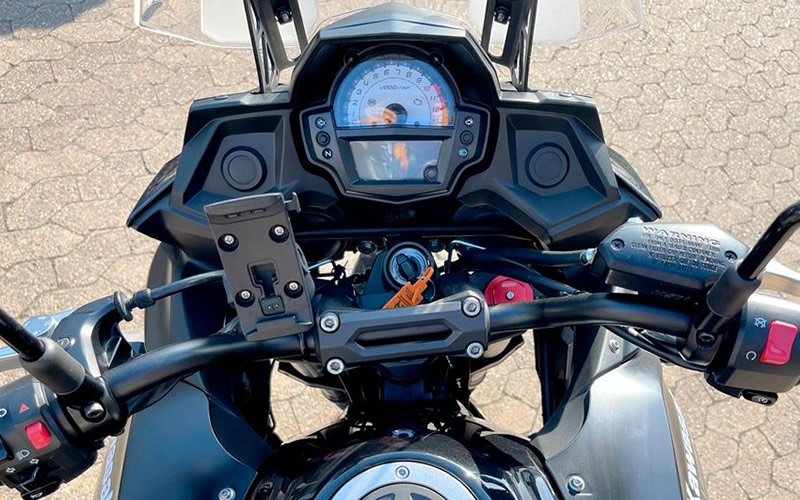
KLE 650 Versys, 2015 year, dashboard
For the 2010 model year, a model update was made, changing the front fairing, mirrors, rear end, and seat. In 2012, Kawasaki launched a sibling model with a larger displacement, the Versys 1000, to capitalize on the successes of other manufacturers in this engine class.
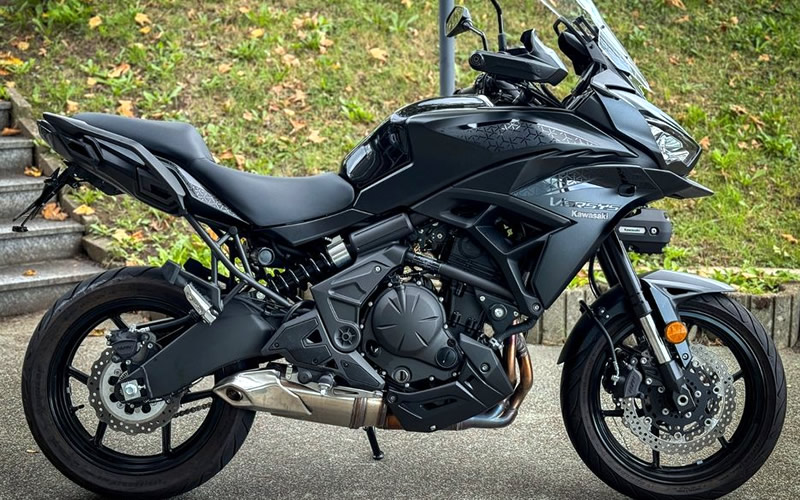
KLE 650 Versys, 2022 year, right view
In the 2015 model year, the Versys was modified again. The narrow front fairing with stacked headlights was replaced with a wider front fairing featuring side-by-side headlights. The windshield was enlarged and is now adjustable in three ways. The rear shock absorber was replaced with a modified shock with a separate preload adjustment mechanism. Additional measures on the engine side increased the power from 47 to 51 kW (69 hp) and the torque from 61 to 64 Nm. Furthermore, the engine was rubber-mounted to reduce vibrations. The fuel tank capacity grew from 19 to 21 liters. The weight of the ready-to-ride motorcycle increased from 209 to 216 kg.

KLE 650 Versys, 2023 year, dashboard
For the 2022 model year, the Versys received a switchable traction control system, a four-way adjustable windshield, additional fairings, and a color 4.3-inch TFT display with smartphone integration.
KLE 1000 Versys (2012-present)
The Kawasaki Versys 1000 (or KLE 1000 Versys) is a motorcycle from the Japanese vehicle manufacturer Kawasaki. The touring motorcycle was presented to the press on November 8, 2011, at the EICMA international motorcycle show in Milan and is manufactured in Japan. The sales name Versys is a portmanteau of the English term "versatile system".
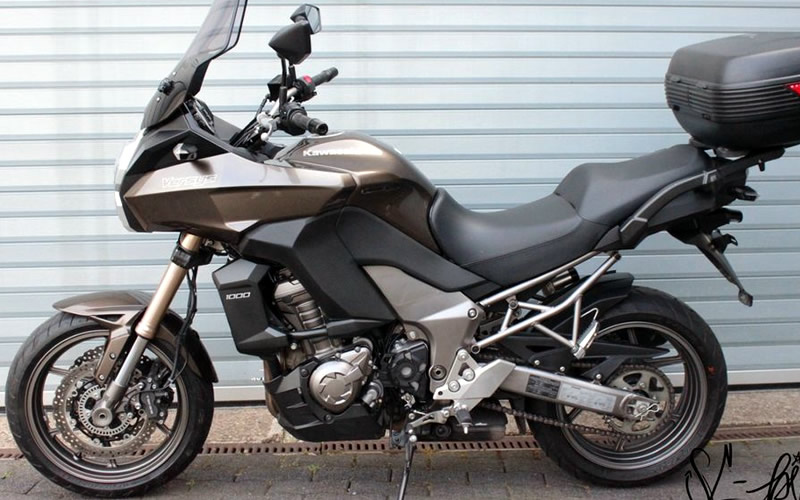
KLE 1000 Versys, 2012 year, left view
The liquid-cooled four-cylinder engine, with a displacement of 1043 cc, is structurally derived from the Z 1000, but it has 1.34 kg more inertia to improve uniformity in the lower and mid RPM ranges, a new cylinder head, and modified timing. The inline engine produces a rated output of 88.2 kW (120 hp) and a maximum torque of 102 Nm at an engine speed of 7500 rpm. The four valves per cylinder head are operated by two overhead camshafts driven by chains via tappets. A balance shaft reduces vibrations. The four cylinders have a bore of 77 mm, and the pistons have a stroke of 56 mm with a compression ratio of 10.3:1.
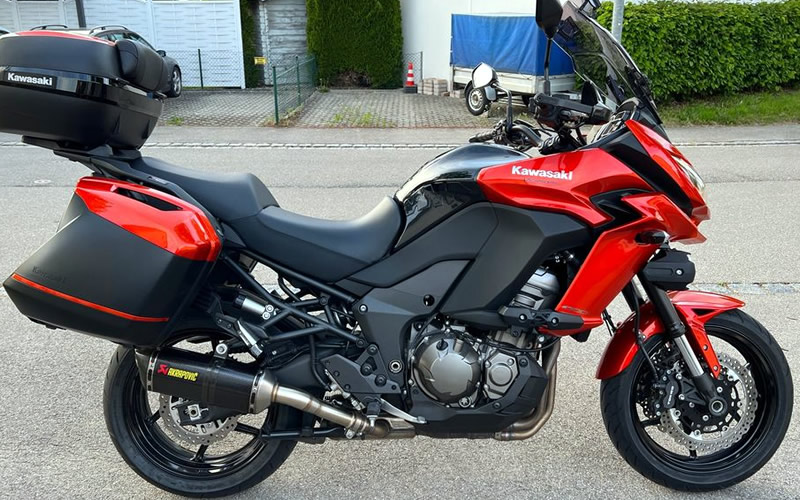
KLE 1000 Versys, 2015 year, right view
The motorcycle accelerates from 0 to 100 km/h in 3.5 seconds and reaches a top speed of 226 km/h. It consumes an average of 5.2 liters of fuel per 100 km and has a theoretical range of 404 km. A three-stage traction control system (Kawasaki Traction Control, KTRC) without lean angle sensors regulates the propulsion.
The chassis is based on an aluminum double-tube frame. A half-shell fairing is mounted around the cockpit carrier. A dual-arm swingarm with a linked shock absorber and 150 mm of travel guides the rear wheel, while an upside-down telescopic fork handles the front wheel. Power is transmitted through a claw-shifted six-speed transmission, with power separation via a mechanically operated multi-plate oil bath clutch and secondary drive via an O-ring chain. The clutch is hydraulically operated. The maximum payload is 212 kg, and the permissible total weight is 459 kg.
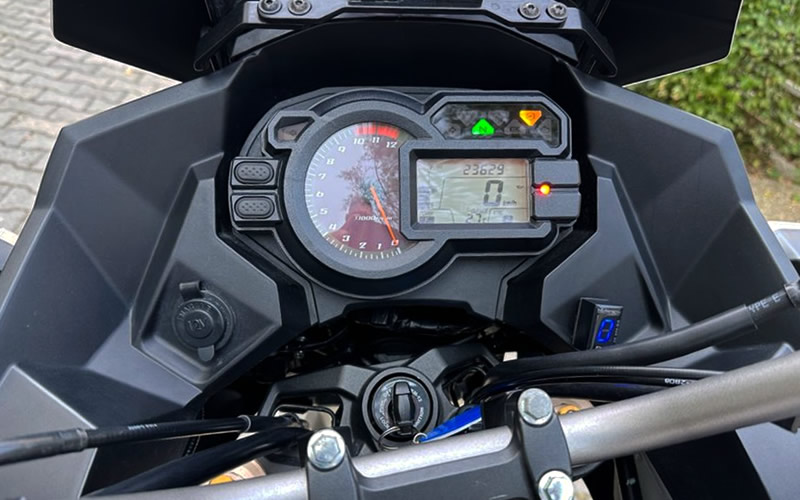
KLE 1000 Versys, 2013 year, dashboard
At the front, braking is provided by two floating-mounted disc brakes with a diameter of 300 mm and four-piston fixed calipers, while a disc brake with a diameter of 250 mm and a single-piston floating caliper is used at the rear. A Bosch anti-lock braking system supports the braking system.
The fuel mixture is generated by electronic fuel injection. The manufacturer recommends using unleaded gasoline with a minimum octane rating of 95. The fuel tank has a capacity of 21 liters.
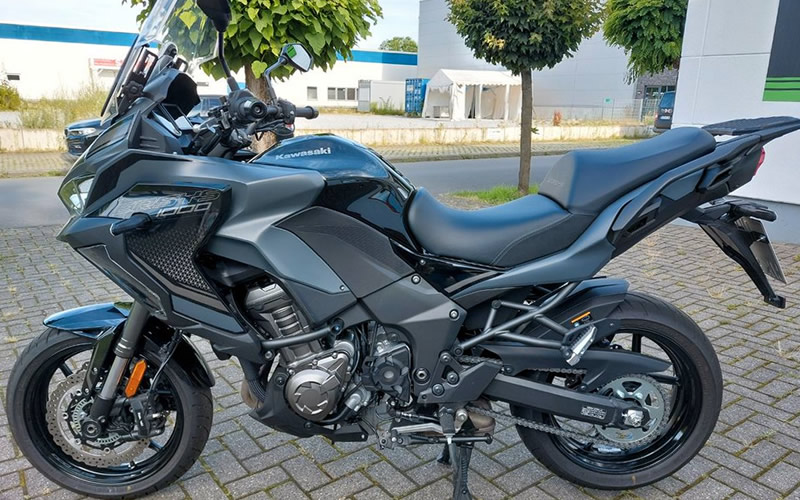
1000 Versys, 2024 year, left view
The starter battery has a capacity of 8 Ah and powers the electric starter. The alternator generates an electrical output of 336 watts. The multifunction instrument unit features an analog tachometer and a liquid crystal display (LCD) with a speedometer, fuel gauge, fuel consumption display, and clock.
The exhaust gases are cleaned by a regulated catalytic converter with a secondary air system, meeting the EURO3 emission standard. The pre-silencer is located under the engine. The four exhaust headers merge at the rear on the right side of the vehicle into a stainless steel end silencer.

1000 Versys, 2023 year, dashboard
Like the smaller model, the Versys 650, Kawasaki made several modifications to the Versys 1000 for the 2015 model year. The front fairing was replaced with a wider one featuring side-by-side headlights. The radiator fairing and turn signal position were also revised, along with the instrumentation. A center stand is now included as standard. Changes to the exhaust end can increased the power by 1.4 kW to now 88.2 kW. The torque is now achieved at 7500 rpm (previously 7700 rpm). The weight increased from 239 to 250 kg due to the modifications.
As one of the last major two-wheeler manufacturers, Kawasaki launched a travel enduro with more than 1000 cc of displacement. The Versys 1000 has a displacement of 1043 cc, which is lower than competitors with around 1200 cc, and it is the only motorcycle in its class with an inline four-cylinder engine. With its 17-inch tires, it is primarily intended for operation on paved roads. The concept is very similar to that of the Triumph Tiger 1050.
- Information for owner
- Maintenance
- Engine and systems
- Engine repair
- Fuel system
- Cooling system
- Lubrication system
- Transmission
- Running gear and frame
- Frame and hinged elements
- Suspension
- Handlebar
- Brake system
- ABS (anti-lock brake system)
- Wheels and tires
- Electric equipment
- Equipment and devices
- Starting and charging system
